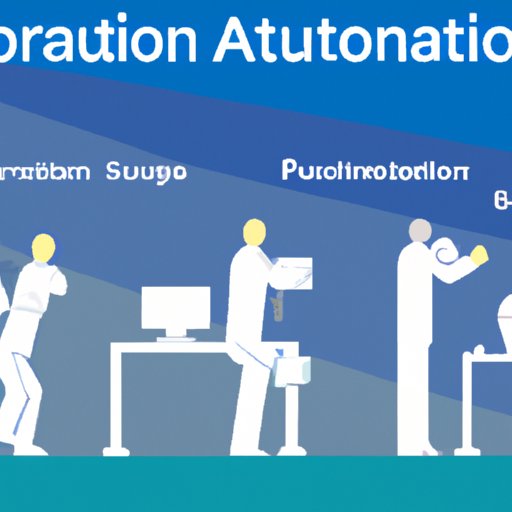Introduction
Automation is one of the most significant emerging trends in the modern workplace, offering businesses the opportunity to increase efficiency, reduce costs, and stay competitive. But while automation can be beneficial, it also comes with its own set of challenges. In this article, we’ll explore the impact of automation on the workplace, examine the pros and cons of automation, and look at the future of automation in the workplace.
Definition of Automation
Automation is the process of using technology to automate manual tasks and processes. It involves the use of machines, software, robots, and other forms of technology to perform repetitive tasks that would otherwise have to be done by humans. Automation can be used to streamline operations, reduce costs, and improve efficiency in a variety of industries and sectors.

Overview of Benefits and Challenges of Automation in the Workplace
The introduction of automation into the workplace offers many potential benefits, including increased productivity, improved customer service, and reduced overhead costs. Automation can also help to reduce human error and improve accuracy in tasks such as data entry, accounting, and customer service. At the same time, automation can lead to job losses and a decrease in wages, as well as a lack of control over automated processes.

Impact of Automation on Jobs and Productivity
One of the most significant impacts of automation is its effect on jobs. Automation has already replaced many jobs that were once performed by humans. For example, automated machines are now used to assemble cars, package products, and process customer orders. As more jobs become automated, there is a risk that entire industries could become obsolete.
At the same time, automation can also lead to increased productivity. Automated machines and software can be programmed to complete tasks much faster than their human counterparts. This can result in higher quality products, faster turnaround times, and better customer service.
Automating Your Workplace: A Guide for Business Owners
For business owners looking to implement automation in their workplaces, there are several steps they should take before making the switch. First, they should assess the tasks that can be automated and identify areas where automation could save time and money. Second, they should consider the cost of implementing automation, including any additional training or equipment that may be needed. Finally, they should develop strategies for managing the transition from manual to automated processes.
Once these steps have been taken, business owners should begin to develop strategies for implementing automation in their workplaces. This could involve introducing automated machines, software, robots, or other forms of technology. Business owners should also consider how to manage the transition from manual to automated processes, such as providing additional training for employees who will be working with automated systems.

How Automation is Changing the Nature of Work
Automation is not only changing the way that work is done, but also the skills and abilities that employers are looking for in their employees. Automation is enhancing employee skills by allowing them to focus on higher-level tasks, such as problem-solving and decision-making. Automation is also streamlining processes, eliminating redundant tasks and creating more efficient workflows.
The Pros and Cons of Automation in the Workplace
Like any technology, automation has its advantages and disadvantages. On the plus side, automation can help to increase productivity and reduce costs. It can also reduce human error and improve accuracy in tasks such as data entry and customer service. However, automation can also lead to job losses and decreased wages, as well as a lack of control over automated processes.

Automation and the Future of Work: What You Need to Know
As automation continues to evolve, it will have a major impact on the future of work. Automation is redefining roles, with many jobs becoming obsolete and new ones being created. Automation is also creating new job opportunities, such as those in the field of artificial intelligence and robotics.
At the same time, automation is changing the nature of work. Employees must now learn new skills to keep up with the changing landscape, and companies must be prepared to invest in training and retraining programs to ensure that their employees remain competitive.
Harnessing Automation to Improve Employee Performance
Business owners can use automation to improve employee performance in several ways. First, they should identify areas where automation can be used to streamline processes and increase efficiency. Second, they should implement automation to reduce manual tasks and free up employees’ time for more productive activities. Finally, they should provide training and support to ensure that employees are comfortable using automated systems.
Conclusion
Automation plays an increasingly important role in the modern workplace, offering businesses the opportunity to increase efficiency and reduce costs. While automation can bring many benefits, it also comes with its own set of challenges. Business owners must carefully consider the costs and benefits of automation before implementing it in their workplace, and must be prepared to invest in training and retraining employees to ensure that they remain competitive in the changing landscape.
By understanding the impact of automation on jobs, productivity, and the future of work, business owners can harness the power of automation to improve employee performance and stay competitive in the global marketplace.
(Note: Is this article not meeting your expectations? Do you have knowledge or insights to share? Unlock new opportunities and expand your reach by joining our authors team. Click Registration to join us and share your expertise with our readers.)
